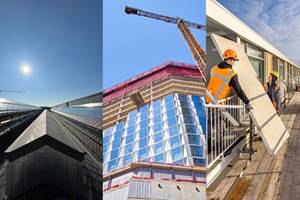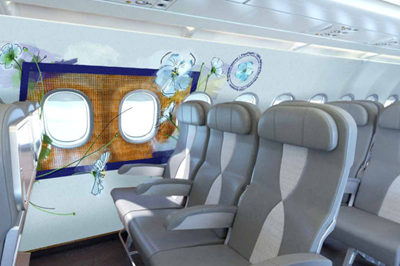Fully recyclable sandwich panel targets aerospace cabin interiors
CAMX 2024: Diab introduces sandwich panels that combine its structural foam core Divinycell F and thermoplastic skins, designed to meet current challenges in sustainability, REACH compliancy and more.
Share
Diab (DeSoto, Texas, U.S. and Laholm Sweden) has developed a new recyclable 100% thermoplastic sandwich panel for aerospace cabin interiors. The thermoplastic sandwich is designed to be a solution to current challenges such as sustainability, REACH compliance and a circular economy.
The solution combines the advantages of Diab’s structural foam core Divinycell F and thermoplastic skins. The materials used have been tested and qualified by aerospace OEMs, and are fully compliant with all industry requirements.
Diab’s sandwich panels for aerospace cabin interiors are made with a custom manufacturing process, including the skins,core bonds and shaping. This can also include decorative skins. Cabin interior panels are produced in a single-step process that yields 30-80% higher mechanical properties and fire resistance behavior than current honeycomb core and phenolic resin solutions, according to the company. The process also decreases weight by up to 10%, reduces production cycle time and reduces production costs by 20%.

Thermoplastic sandwich panels.
Divinycell F is a 100% thermoplastic Divinycell F core material that is already REACH-compliant. It is said to be recyclable and has a zero-waste production process. A sandwich core for commercial aircraft interiors, it is FST-compliant, has low sensitivity to water absorption, optimizes surface finish and reduces labor times. Another focus is its sustainability, which it offers through use of a recycled core.
Diab says it has demonstrated the recyclability of the panel with a process consisting in grinding the panel, then extruding recycled pellets and finally injection molding into 3D parts. Other recycling scenarios are said to be possible.
Related Content
-
Bio-based, fire-resistant composites become mainstream
Projects use Duplicor prepreg panels with highest Euroclass B fire performance without fire retardants for reduced weight, CO2 footprint in sustainable yet affordable roofs, high-rise façades and modular housing.
-
Guidance for the thermoforming process
A briefing on some of the common foam core material types, forming methods and tooling requirements.
-
Composite SIPs for more affordable, efficient and sustainable buildings
LiteSIP panels and modules enable framing in days, cutting structural labor and total cost by up to 70% and 30%, respectively, while increasing energy efficiency and durability.
Related Content
Bio-based, fire-resistant composites become mainstream
Projects use Duplicor prepreg panels with highest Euroclass B fire performance without fire retardants for reduced weight, CO2 footprint in sustainable yet affordable roofs, high-rise façades and modular housing.
Read MoreGuidance for the thermoforming process
A briefing on some of the common foam core material types, forming methods and tooling requirements.
Read MoreComposite SIPs for more affordable, efficient and sustainable buildings
LiteSIP panels and modules enable framing in days, cutting structural labor and total cost by up to 70% and 30%, respectively, while increasing energy efficiency and durability.
Read MoreAirbus video highlights RACER compound helicopter first flight
Launched as part of a Clean Sky 2 program, a compound design — rotor, split fixed-wing, propulsive propellers — uses composites to cut fuel consumption and emissions by 20%.
Read MoreRead Next
Diab reduces carbon footprint by 46%
Between 2016 and 2021, the sandwich composite solutions company made alterations in material, reduced waste and efficient use of waste, production and energy sources to drive its reduction efforts.
Read MoreLufthansa Technik, Diab develop greener composites for interior cabin components
Aeroflax flax fiber-based prepreg and one-step thermoplastic manufacturing process for 100% recyclable panels production pioneer lighter weight, reduce CO2 emissions.
Read More“Structured air” TPS safeguards composite structures
Powered by an 85% air/15% pure polyimide aerogel, Blueshift’s novel material system protects structures during transient thermal events from -200°C to beyond 2400°C for rockets, battery boxes and more.
Read More






